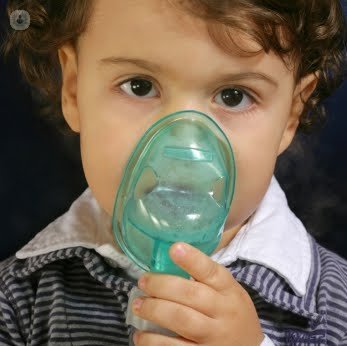most common allergic diseases in childhood
Written by:The number of children with allergic disorders is increasing in Europe.

Major allergic diseases in children
Allergists talk about "the allergic gait" to designate the evolution that usually atopic children suffer throughout their lives. Atopic children are those who are genetically predisposed to allergic diseases. Mention will be made, in chronological order, of the problems usually posed by these atopic children, although an allergic disease can begin at any time in life, without the patient having hitherto shown any signs.
First year :
Many atopic children show allergic symptoms from the first months (even days of life) if they are sensitized to the foods they eat. Food allergy in infants within a few months may lead to the following manifestations:At the digestive level: intestinal cramps, vomiting, diarrhea, malabsorption of food, which can lead to delayed growth.
At the skin level:- Urticaria : lesions looking like hives or hives, usually sudden onset, of variable size and relatively well delimited, which can affect any point of the body. They are accompanied by intense pruritus (cutaneous itch).- Angioedema : swelling and edema of the skin, especially of the soft parts: eyelids, auricles, lips, etc.- Atopic Dermatitis or Atopic Eczema : children with very intense itch in the skin that causes them to scratch themselves compulsively, being able to provoke scratches and wounds. The main clinical manifestation is eczema: areas of the skin reddened on which appear small blisters that, when broken, release a liquid (exudation) that favors the formation of scabs. The location of eczema varies with age, affecting infants on the face and the surface of arms and legs. In older children they tend to be located in elbow and knee flexures.

Children who suffer from atopic dermatitis have genetic alterations that result in a delicate, easily irritated skin that responds exaggeratedly. The foods most allergic to children of this age are: cow's milk, egg, cereals and fruits , which are the foods most used in feeding babies. In most cases, these children will tolerate the food completely if, once the responsible food is known, a diet free from the food is made, but it does not happen in all cases. Care must be taken with the reintroduction of the eliminated foods and must always be done under indication and control of the allergologist. In addition, these patients may in the future become sensitized to other allergens and may suffer from allergic respiratory diseases such as asthma or rhinitis, so their evolution should be monitored.
First to fifth year of life :Obstructive Bronchitis or Non-allergic Childhood Asthma is usually present at this age.. Many atopic children, due to the exaggerated reactivity of their skin and, as well as other non-atopic children who have suffered during the first months of life damage to the bronchial mucosa due to various causes (tobacco smoke, prematurity, need for oxygen treatment , bronchiolitis ...) may present episodes of respiratory distress (fatigue and choking sensation) during the first 4-5 years of life, which are usually accompanied by noises in the chest, coinciding with viral infections or catarrhal episodes. usually accompanied by fever.
Some doctors call these episodes obstructive bronchitis or spastic bronchitis. Others, however, are called non-allergic bronchial asthma. The important thing is to know that, although it is distressing, usually are not usually allergic problems and usually evolve towards spontaneous remission (cure) around 5-6 years. If the child does not become allergic this type of pictures do not repeat themselves. This favorable evolution usually occurs in 80% of cases. If the child becomes allergic, he or she will have a poorer prognosis and, sometimes, after partial improvement, their obstructive bronchitis often progresses to asthma or allergic rhinitis.
Sixth to tenth year of life :
At this age, typically, allergic diseases of the respiratory tract are usually initiated:• Allergic rhinitis : It is the most frequent of the allergic diseases and can be present in more than 10% of the children of school age. It is an inflammation of the nasal mucosa that thickens and produces:- Nasal obstruction : the air makes it difficult to pass, causing a very annoying feeling that requires breathing through the mouth.- Discharge of liquid and mucus or distilled through the nostrils and requires the use of countless tissues.- Sneezing : Series of several sneezing in a row- Nasal pruritus: Severe itching at the level of the nostrils, which repeatedly forces the nose to rub. The itching can spread to the throat, the palate, and also to the eyes and ears.
 If the child has become allergic to allergens that are always present in their environment (house dust mites, molds, animal hair, etc.) they will suffer these symptoms throughout the year ( Perennial Rhinitis ). If you are allergic to pollen, you will suffer the symptoms only at times of pollination ( Seasonal Rhinitis ), different depending on the pollens.
If the child has become allergic to allergens that are always present in their environment (house dust mites, molds, animal hair, etc.) they will suffer these symptoms throughout the year ( Perennial Rhinitis ). If you are allergic to pollen, you will suffer the symptoms only at times of pollination ( Seasonal Rhinitis ), different depending on the pollens.
Allergic rhinitis can be maintained for many years with little clinical significance, but seldom occurs spontaneous improvement and left to evolve, without adequate treatment, tend to evolve towards bronchial asthma.
• Bronchial asthma. Bronchial asthma is a condition characterized by transient (reversible) episodes of narrowing of the airway, which obstructs the normal passage of air to the pulmonary alveoli. It manifests as Access (Crisis) of respiratory difficulty (fatigue or feeling of suffocation) that is accompanied by coughs and noises in the chest (whistles and whistles). It is not usually accompanied by fever. It is a relatively frequent disease and it is estimated that it suffers from 5% of children of school age.
Not all asthmatic children are allergic but allergy is the cause of most asthma cases. More than three-quarters of people with asthma suffer from allergies. Left to their spontaneous evolution, children with allergic asthma usually do not improve but experience progressive worsening. However, with correct diagnosis and adequate treatment, most cases are controlled and can carry out a completely normal work and sports life and even in a significant percentage are obtained remissions of their symptomatology for years or definitively.
Ten years on :
In addition to the above mentioned diseases the atopic patient can develop at any time of his life sensitization to some new food or to a drug that can cause urticarial reactions and / or angioedema. Unlike the food allergy that occurred in the first months of life, children who are sensitized to foods at a later age often do so more often with fruit, vegetables, fish, shellfish, nuts, etc.. They improve on their symptoms with food exclusion diets but rarely become tolerant.
Two infrequent allergic conditions in children but which, when produced may be very serious, are allergy to drugs and allergy to bee sting or wasp. Before the suspicion of both must be made an allergic study urgently. Both types of allergy usually give quite alarming clinical manifestations that the doctors call anaphylaxis or anaphylactic shock :- Generalized urticaria outside the site of the bite, in case of insect bite- Respiratory symptoms: sneezing, coughing, whistling, shortness of breath- Loss of consciousness
In such cases, an allergist should be consulted urgently. A new administration of the drug or a new sting in an allergic child can even lead to death, something that can be avoided, in most cases, with an allergy vaccine.


